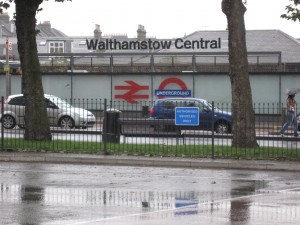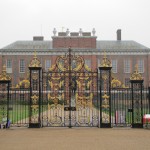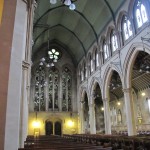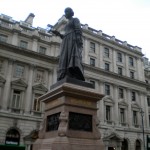Entries from August 2010
August 26th, 2010 · 1 Comment
Today for our tube exercise, we were sent in search of Marleybone, an area just south of Regents Park. We initially had trouble finding the Goodge Street tube station, because it is actually on Tottenham, near the intersection with Goodge. It took us about fifteen minutes total to locate the stop, which is easily withing walking distance. Emily found the entrances to the tube to be more maze-like than any US subways, but we were successful at navigating and switching lines once underground. We got off of the tube at Oxford Circus, which is named because of its proximity to an intersection with the same name. People probably travel to this stop mostly in their leasure time, and especially to shop. However, we later realized that we could have gotten closer to our destination by taking the rout to Great Portland Street instead.
[/caption]
<a href=”http://blogs.dickinson.edu/norwichhumanities/files/2010/08/blog-and-stuff-0281.jpg”><img src=”http://blogs.dickinson.edu/norwichhumanities/files/2010/08/blog-and-stuff-0281-225×300.jpg” alt=”” title=”blog and stuff 028″ width=”225″ height=”300″ /></a>
Much of the area was devoted to shopping and restaurants. We could tell that this was an expensive shopping district due to the foreign brand name boutiques, and diverse restaurants and cafes (mostly not fast food). These shops and restaurants were all on the bottom floors of buildings that fit an older architectural style, that followed a certain uniformity. We noticed that the area seemed populated with mostly young people, but also individuals and groups that were diverse, age-wise and ethnically. Most of these people there seemed to have time on their hands, since they did not seem to be in a rush. They seemed more likely to be there for the afternoon than for a short lunch break.
Plaque on a building, apparently dating back to 1863
<img src=”http://blogs.dickinson.edu/norwichhumanities/files/2010/08/blog-and-stuff-0261-225×300.jpg” alt=”” title=”blog and stuff 026″ width=”225″ height=”300″ />
On one main street in this Marleybone, an entire block was lined with buildings with inscriptions such as “The Institute of Physics,” and “The Institute of Architecture.” We were not sure whether these were currently in use as schools or parts of a university, but we did find evidence that schools have existed in this area for a long time. A plaque on a tall red brick building that did not match up exactly with those around it dedicated a school to the father of the woman who founded it in 1863. We would like to know more about the history in that area.
<a href=”http://blogs.dickinson.edu/norwichhumanities/files/2010/08/blog-and-stuff-017.jpg”><img src=”http://blogs.dickinson.edu/norwichhumanities/files/2010/08/blog-and-stuff-017-300×225.jpg” alt=”” title=”blog and stuff 017″ width=”300″ height=”225″ /></a>
Tags: 2010 Emily · 2010 Sean
August 26th, 2010 · 1 Comment
For our Tube exercise, we travelled to Walthamstow. It is relatively far east (think Salaam Brick Lane east).
We started our journey at the Goodge Station and took the Northern Line north to the Warren Street station where we changed lines and rode the Victoria Line all the way east to the Walthamstow Central Station.
On the Tube, as in Watching the English, most people just kept to themselves. A few people were conversing loudly, but this was not the norm. Most people were travelling by themselves and avoided eye contact.
We noticed that the number of people on the line thinned out as the train travelled east. This seemed to be a reflection upon the geographic location of the stop and its relation to the socioeconomic standing of that area of London.
The obvious reason that people would travel to this stop is its proximity to nearby train and bus stations as well as open-air markets and shopping centers.

The area surrounding the station seemed to be primarily Afro-Caribbean and Middle Eastern. Many of the shops were targeted towards- and in fact, labelled for- these ethnicities.

Interactions between people on the street and in the mall were very lively and fast-paced. We observed (and heard) a vendor singing to advertise his goods and his patrons joined in. The fruits and banners in the market were brightly colored and visually stimulating, adding to the vibrancy and vividness of the scene.
Although there were no traditional monuments or plaques in the area, we came upon a library that was an interesting blend of modern and 18th – early 19th century design.

The architectural grandeur and elegance of its exterior served as a sort of centerpiece for the neighborhood.
In order to get back to Arran House, we took the Victoria Line from Walthamstow Central Station to the Finsbury Park Station. We then switched to the Picadilly Line and followed it to Holburn Station. From there we braved the rain and made our way (slowly) back to the hotel.
While on the underground on the way home, we had a fairly similar experience to that of the original trip. It was relatively uncrowded- we were able to sit all the way back- and people did not interact. A pair of men who had been talking loudly in the station continued their conversation on the train, much to the annoyance of a young mother sitting near them. She did not chastise them for their behavior but instead quietly looked away and rolled her eyes. This simple interaction seemed to us to be quintessentially British, at least based on Kate Fox’s observations.
Tags: 2010 Jessica · 2010 Patrick
Our adventure through London commenced with a magical trek from Arran House to Euston St. where we crossed the scariest intersection ever, and got onto the Underground at the Warren Street Station. We passed several colleges on the short walk there. Upon entering the Tube, we were nearly stampeded by what we assumed was a mass of English people fleeing Godzilla, but apparently it was just the normal speed people walk on the left side of the playbill decorated escalator (only the right side is for standing). On the approximately 10 minute ride, we noticed a lot of traditional religious dress, including Jewish men wearing yarmulkes and Muslim women wearing head scarves. This manner of dress was replaced in a dramatic way upon our exit from the station onto main street of Camden Town, part of the Borough of Camden in northwest London, by another form of culturally-influenced dress. The downtown area was filled with many aspects of thriving goth and punk sub-cultures. Tattoo parlors advertised themselves with what looked like controversial picket signs, reflecting a style rooted in subversive movements. Punk and alternative clothing outlets (some with plastic mannequin legs covered in ripped tights in place of awnings), independent record sales on corners, and many, many piercings filled every inch of the street (We received 4 piercing pamphlets within 5 minutes of arriving). Dreadlocks and mohawks ruled the day. This was very much in keeping with the spirit of Camden Town, though not in regards to its original namesake, the 1st Earl Camden, but rather by the integral part it played (and continues to play) in the development of the goth, punk, and underground music sub-cultures.
In addition to still being a gathering place for rebellious youth, Camden Town also features a huge variety of ethnic cuisine in fast food or market formats. The Camden Town Market appears to be an eccentric, large, and broad conglomeration of peoples and things from throughout the world. Throughout the Market, there were large bronze statues of lions in a Sphinx-like pose, an image that was repeated in all of the Market’s advertising. These figures’ effect on the population was amusing to behold as tough teens went over to pose with the statues, which represent the area that reflects their anti-conformist natures. Unfortunately, when we were preparing to take a picture of one of the monuments, we were caught in heavy rain which might have damaged the camera, and turned our return trip to the Arran House into a much less pleasant and enjoyable endeavor, as we had arranged our Tube departure to allow us to walk most of the way home, through Bloomsbury via Camden Town to Tottenham Court Road, where we changed direction and took Bloomsbury Street until it became our own Gower Street. On a brighter note, we did get to see some of those awesome Harry Potter-esque double decker buses.
Tags: 2010 Elizabeth · 2010 Jesse · 2010 MatthewM
August 26th, 2010 · 1 Comment
This afternoon, we saw more of London than we bargained for. Our goal for the assignment was to visit the Kensington High Street (KHS) Tube stop; our navigational skills are clearly wanting at this stage in the game, as an 8 mile round trip took nearly two hours. The following is a recap of our jet-lagged travels.
We managed to go the wrong way out of the front door of the Arran House, as our goal was to take the Circle Line from the Euston Square stop to the KHS one. A genius plan, as we could cover the requirement to take a different route there and back by circumnavigating the Circle in opposite directions. Alas, that would have required making a left out of the Arran House. We made a right. We ended up stumbling on to the Tube at Tottenham Court Road, which could have been an only slightly shorter Tube trip. Fortunately, construction at the Bank stop thwarted our plans, and we took the Central Line all the way out to Liverpool Street before finally connecting to the Circle. Conservatively, this foray took 40 minutes. We took the simpler (and quicker) return path of the Circle back to Euston Square.
Unless it is indeed not as obvious as we think, the KHS station is named for the nearby Kensington Palace and Gardens. The Tube presumably stops there because the surrounding area is an upper class shopping district. The American supermarket Whole Foods, typically found in wealthier locales in the states, had a massive store right down the street from our stop. It is located in the Royal Borough of Kensington and Chelsea.
On our way to Kensington Palace, we stumbled upon a war monument dedicated to the men from Kensington who died in “The Great War.” The monument was situated just outside of an old church, St. Mary Abbotts. St. Mary is a Victorian building in the English Gothic revival style. (A church has been on that site since the 9th century.) Leaving, we got directions (albeit quite circuitous ones) to the palace from a church attendant. Our time was cut short in exploring the area around the palace and its gardens because of the rain. However, we did stumble upon the Romanian Embassy.
Who was on the street? Well, in our brief and informal survey of the neighborhood, there were a lot of pigeons, haughty rich people, tourists, and improbably, two policemen armed with automatic weapons and sidearms. (They followed us for almost two blocks). The area of the neighborhood that we walked in was largely a upper-middle-class shopping district; residences were not readily noticeable. The architecture was an eclectic mix of what appeared to be Victorian-era buildings and more modern stereotypical shopping centers.
Overall, it was quite an enjoyable adventure, despite the rain and the initial issues with the Tube.
Tags: 2010 Dennis · 2010 Stephenie
August 26th, 2010 · 1 Comment
Professor Qualls assigned us Piccadilly Circle. The hardest part was figuring out what Tube station to start from – we didn’t know what was the closest to the Arran Hotel, so that took a little bit of aimless walking around Tottenham Court Road (not that we’ce complaining). It was the Goodge Street station we were after, and we think that being able to find it will be useful before long.
Matt spent the summer in New York City, and Mary Kate has used the New York subway on occasion, and neither of us has ever seen anything quite like the Tube. Its walls are plastered in colorful ceramic tile – untainted by graffiti – and the advertisements lining the walls of the railway promote opera and theater. In speaking of opera, the performers trying to make money in the subway seem to have a different repertoire here: we heard an opera singer and soft-rocker on a keyboard in our stations today. The Goodge Street station also featured a winding staircase of 136 stairs – we were surprised when we expected to run down two flights as a quicker alternative to the lift.
We took Goodge to Tottenham Court Rd, and from there we transferred to the Piccadilly Line at Leicester (pronounced “Lester”?) Square. None of our rides on the Tube were longer than 90 seconds, and every time we found our platform, the Tube train was already waiting for us. (The instant train access was another thing we weren’t used to from American subway systems.) When we climbed out of the Piccadilly Station, named for the Piccadilly Circus, and into the City of Westminster, we felt a world away from Gower Street. “This is the Times Square of London,” Matt immediately remarked. Flashing lightbulbs, MacDonald’s advertisements (and stores), punk rockers with orange spiked hair posing for pictures (for a few quid), and plenty of traffic made us feel more like we were in an American city than we have felt yet. The architecture of the buildings , though– on the second level, above the franchise coffee shops and tourist-y clothing stores – reminded us we were in London: regal brick and stone with ornate facades, often topped with statues or domes lined the streets in all directions. Several tourists asked us to take their pictures in front of statues, and we spotted a few posing outlandishly in front of fountains.
Our favorite memorial statue in Piccadilly Circus was a little further away from the hustle and bustle surrounding the central fountains and monuments. We gravitated toward the Crimean War memorial. (Although it should be noted that actually getting across traffic to reach the memorial is much easier said than done.) It featured a statue of Florence Nightingale, where people continue to leave bouquets of flowers in her honor.
Getting back to the Arran House (even in our fog of jet lag), proved to be a snap. We took a different route – Piccadilly to Oxford Circus to Tottenham Ct. Rd. and a three-block walk home – and got to see a few pubs and store fronts we missed the first time around.
Tags: 2010 MaryKate · 2010 MatthewG
My second year as director has begun. I have been in London for a few days now making sure there are no problems on my walking tours, finalizing tickets and guest speakers, getting materials for the arriving students, and much more. In the morning i leave to pick up the new group of students at Heathrow. Because I know only one so far, I really look forward to meeting the students and learning more about them. The weather does not look to be kind for our first few days, and traffic problems associated with the Bank Holiday weekend, Tube maintenance, and the Nottinghill Carnival all promise to be a challenge for us. But we must simply “Keep calm, and carry on!”
Tags: Professor Qualls








